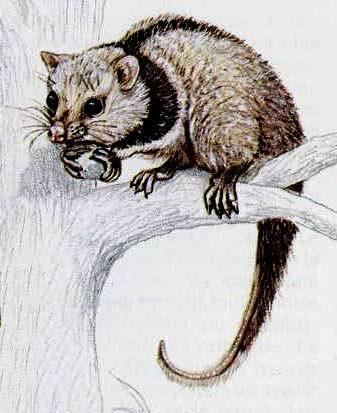Family Didelphidae Scientific name Caluromysiops irrupta Rank Species | Phylum Chordata Order Didelphimorphia Higher classification Caluromysiops | |
 | ||
Similar | ||
The black-shouldered opossum (Caluromysiops irrupta), also known as the white-eared opossum is an opossum known from western Brazil and southeastern Peru. It was first described by Colin Campbell Sanborn, curator of Field Museum of Natural History, in 1951. The black-shouldered opossum is characterized by a gray coat, gray underbelly, and broad black stripes that extend from the forefeet, meet on the shoulders, run along the midline of the back and then split into parallel stripes that run down the hindfeet. Little is known of the behavior of the black-shouldered opossum. It is nocturnal (active mainly at night) and arboreal (tree-living); it is known to feed on fruits and rodents. The opossum inhabits humid forests. The IUCN classifies it as least concern.
Contents
Taxonomy
The black-shouldered opossum is the sole member of Caluromysiops, and is placed in the family Didelphidae. It was first described by Colin Campbell Sanborn, curator of Field Museum of Natural History, in 1951. No subspecies are recognized.
The cladogram below, based on a 2016 study, shows the phylogenetic relationships of the brown-eared woolly opossum.
Description
The black-shouldered opossum is characterized by a gray coat, gray underbelly with buff-tipped hairs, and broad black stripes that extend from the forefeet, meet on the shoulders, run along the midline of the back and then split into parallel stripes that run down the hindfeet. Indistinct dark lines run through the eyes. 60 to 75 percent of the length of the tail is darker than the coat dorsally (on the back), while the rest is white. Except for the last 75 percent of the length at the base, the tail is bushy. Like Caluromys species, its fur is soft, thick and woolly, and has a similar skull. However, it differs from them in having a shorter rostrum and larger molars. The head-and-body length is between 25 and 33 centimetres (9.8 and 13.0 in) and the tail measures 31–40 centimetres (12–16 in). The hindfeet measure 6.7 centimetres (2.6 in), while the ears 3.7 centimetres (1.5 in).
Ecology and behavior
Little is known of the behavior of the black-shouldered opossum. It is nocturnal (active mainly at night) and arboreal (tree-living). It spends a significant amount of time on trees, mainly on high branches. Studies suggest individual diet preferences; the opossums feed on rodents as well as fruits. Lifespan in captivity has been known to exceed seven years. Up to two young have been recorded.
Distribution and status
The black-shouldered opossum occurs in humid forests of western Brazil and southeastern Peru, and probably in Bolivia as well. It is known only from five different localities. The IUCN classifies it as least concern given its wide distribution and presumably large population. A possible threat to their survival is deforestation.
